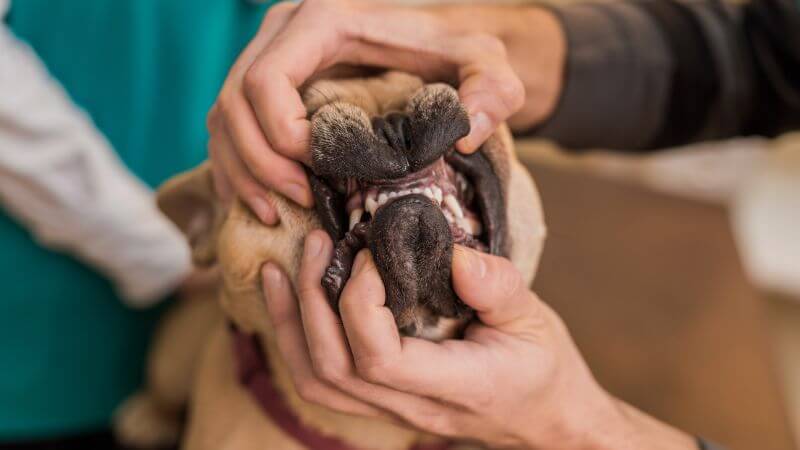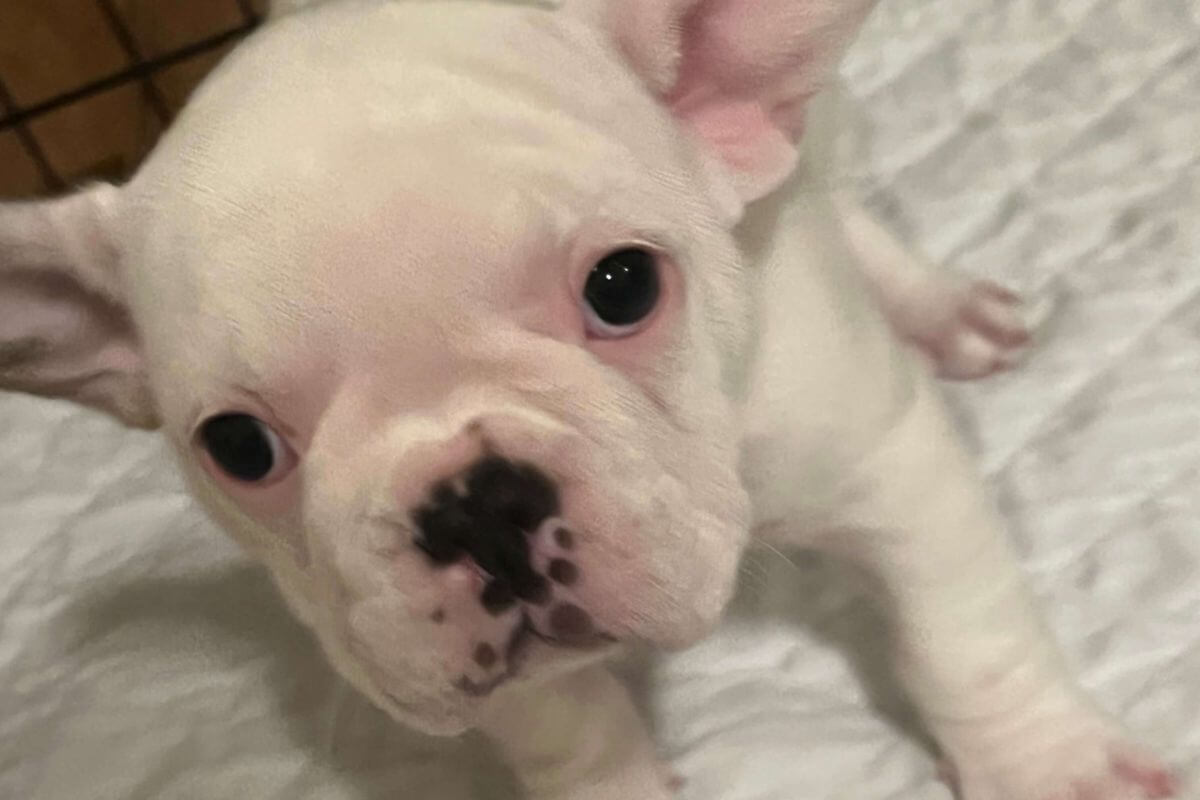There’s a lot to know about your French Bulldog teeth.
Every dog, regardless of breed, has 42 teeth. However, dogs with small snouts (like French bulldogs) often have a different tooth structure due to the condensed space that’s forced to fit all those teeth.
Because of this, French bulldogs have wry teeth instead of teeth sitting in a straight line.
In the article below, you’ll read everything you need to know about the structure of your French bulldog’s teeth and some of the major health concerns caused by this structure.
French Bulldog Teeth Structure
French bulldogs are brachycephalic dogs, meaning they have short or flattened noses instead of longer snouts.
All dogs have 42 teeth, even brachycephalic dogs. While larger dogs have no problem fitting all 42 teeth into their elongated skulls, Frenchies’ teeth don’t fit neatly into the space they have.
Their short skulls cause a number of problems for their tooth structure. Instead of sitting in a straight line, their teeth are wry.

French bulldogs also have undershot underjaws, giving them an unusual bite (when compared to larger dogs with normal skull shapes).
Most French bulldogs have an undershot jaw that curves slightly upward, causing the lower incisors to rest in front of the upper incisors.
Since there’s no “normal” gap size between these teeth, each individual Frenchie has their own uniquely positioned teeth.
There is some variation in how a French bulldog’s jaw can be positioned. They may also have a straight underjaw, creating a normal bite (without the undershot jaw).
However, this variation is relatively rare, since most Frenchies have some amount of an underbite.
Frenchies have 20 teeth on their upper jaw and 22 teeth on their lower jaw. These teeth include twelve incisors, four canines, sixteen premolars, and ten molars.
The following is a short explanation of the structure and use for each type of tooth.
Incisors
There are six of these teeth on the upper jaw and six more on the underjaw. While most of the incisors are small and flat, two of them (on the upper jaw) are a little bit pointed. This type of tooth is used for gnawing and scraping.
Canines
Each jaw has two canines on it. These teeth are long and pointed. The incisors and canines form in a straight line, although only in French bulldogs with broad and square underjaws. Frenchies use these teeth to tear their food (especially tough food like meat).
Premolars
Frenchies have eight premolars on each jaw. These teeth sit behind the canine teeth. They have very sharp edges, used to shred and chew food. Your French bulldog also uses these teeth when playing with teething toys or chewing on sticks.
Molars
French bulldogs have four molars on their upper jaw and six on the lower. These teeth are designed for grinding and breaking teeth into small pieces before swallowing.
French Bulldog Teeth Problems
If you’re thinking about getting a Frenchie, there’s a few dental problems that you need to be aware of.
Unfortunately, a French bulldog’s tooth structure can cause a number of health problems. Since they fit all those teeth into such a small space, Frenchies are unusually prone to health problems related to their teeth.
The following are a few of the most common health concerns related to tooth structure in brachycephalic dogs like the French bulldog.
Overcrowded Teeth
While the basic structure of a French bulldog’s teeth means crowding will always be a problem, sometimes the teeth can become overcrowded. This causes a whole host of problems, including discomfort or difficulty chewing.
Sometimes these problems can get worse over time. As your dog matures into adulthood and later in his senior years, physical changes may cause the overcrowded teeth to become even more uncomfortable.
If you notice your dog eating less, taking longer to chew, or drooling more, you should have him evaluated by a veterinarian to rule out dental problems.
Damage to Soft Tissue
The soft tissue in your dog’s jaw is particularly vulnerable to damage from their misaligned teeth. In most dogs, the upper and lower incisors are meant to be offset.
Because of the condensed space for a French bulldog’s teeth, the incisors are often arranged so that they line up with each other.
This causes the upper and lower incisors to rub against each other when your dog chews. Over time, the way the incisors rub together wears out the soft tissue in your dog’s jaw.
Swelling, bleeding, and irritation are often caused by this repeated clash between upper and lower incisors.
Plaque and Tartar Buildup
Whenever your French bulldog eats, a coat of saliva, bacteria, and food particles will coat his mouth. This thin film (called plaque) coats the entire inside of your dog’s teeth and gums.
Over the following one to three days, the salts in your dog’s mouth turn plaque into tartar.
Tartar is a yellowish coat that forms and accumulates at the bottom of the visible portion of your dog’s teeth. While you’ll see it where the gumline and visible teeth meet, it also extends below the gumline.
While both of these naturally accumulate, tartar is a problem because it often causes an unhealthy buildup of bacteria in your dog’s mouth.
This puts your dog at higher risk for infection. Since the tartar buildup extends below the gum line, bacteria can easily enter your Frenchie’s bloodstream.
Plaque is extremely easy to remove with regular brushing and dental hygiene habits. However, tartar buildup is usually much more difficult to remove.
Since plaque eventually turns into tartar, it’s important to remove it while you still can. Regular brushing and dental checkups are important for more than just dental health!
Gum Disease
Another common health concern related to a French bulldog’s tooth structure is gum disease.
When plaque and tartar form on a dog’s teeth, they can develop one of two kinds of gum disease. Gingivitis and periodontal disease are both extremely common in brachycephalic dogs.
Your French bulldog might have gingivitis if her gums become swollen and irritated. In severe cases of gingivitis, your dog might experience bleeding gums.
While gingivitis only impacts your dog’s gums, untreated gingivitis can turn into periodontal disease.
Periodontal disease is significantly more severe than gingivitis. This condition doesn’t just impact the gums but your dog’s teeth and roots.
Because periodontal disease impacts the roots, the internal structure of your dog’s entire jaw is compromised.
Over time, your dog’s teeth and jaws can become fragile. This makes pain and breaks significantly more likely.
Because of the escalating nature of gum diseases, it’s important to monitor and treat them. You can prevent gingivitis from developing into full-blown periodontal disease with proper treatment.
Loose Teeth
Since French bulldogs have so many teeth crammed into such a small space, they are especially prone to crooked or loose teeth. Their teeth don’t sit neatly in a row, causing their roots to be less secure in the jaw.
Everyday activities like eating and chewing can cause their teeth to loosen. Loose teeth can often cause pain. In some cases, they may break or fall out, causing long-term problems for your dog.
Worn or Broken Teeth
French bulldog teeth do not align perfectly like the teeth in larger dog breeds. When they close their mouths, their teeth will rest on top of each other instead of leaving gaps in the jaw.
This bite pattern causes teeth to rub together in unhealthy ways while eating or gnawing.
Sometimes Frenchies don’t have a severe underbite. In these cases, worn and broken teeth are less likely to occur. However, some French bulldogs experience extensive dental problems caused by their overcrowded teeth.
Infection
Since French bulldogs often experience more wearing on the soft tissue in their mouth, they’re typically more susceptible to infections caused by oral exposure.
In some cases, dogs can cause wounds to their gums, leaving them vulnerable to bacteria and other diseases.
Because of this risk, you should regularly examine your French bulldog’s teeth and gums to make sure there aren’t any new or worsening problems.
Staying on top of their dental health can help you prevent escalating symptoms caused by infections.
Abscess
As noted in several of the health concerns above, bacteria can thrive in the environment caused by a Frenchie’s tooth structure.
When dental hygiene is neglected, the spread of bacteria can run rampant. When combined with a broken or damaged tooth (a common occurrence in French bulldogs), the bacteria can create an infection in the root of a tooth.
This creates an abscess. Abscessed teeth are extremely painful and require prompt medical attention.
Your dog may have long-term problems if an abscess develops, making it extremely important to stay on top of their dental hygiene regime.
Malnutrition
Many French bulldogs struggle to chew due to their tooth structure. When the mouth is wounded, or gum inflammation occurs, your dog may feel less inclined to eat.
Untreated dental problems, such as periodontal disease and abscesses, may make eating downright painful.
Malnutrition occurs when your dog is not getting enough nutrients over a long period of time.
Neglecting their dental health needs can have a negative impact on your dog’s overall well-being, which is one of many reasons why it’s so important to regularly check their teeth and gums for signs of infection or injury.
Wrap-Up: French Bulldog Teeth
In conclusion, French Bulldogs have unique dental needs due to their short snouts and crowded mouths.
Regular dental checkups and cleanings, as well as a proper diet, can help maintain the health of their teeth and gums.
It’s important to pay attention to any signs of dental issues, such as bad breath or difficulty eating, and to address them promptly.
Proper dental care can not only improve your French Bulldog’s overall health but also help them live a happier and more comfortable life.
